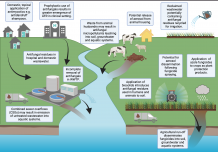Articles

Antifungal Exposure and Resistance Development
Exeter's Medical School, MRC Centre for Medical Mycology, and Environment Agency publish government report on antifungal resistance
Exeter's Medical School, its MRC Centre for Medical Mycology, and the Environment Agency have published a government report on antifungal resistance.
Titled 'Antifungal Exposure and Resistance Development: Defining Minimal Selective Antifungal Concentrations and Testing Methodologies', the Environment Agency government report version of this publication can be read on the gov.uk publications site.
Antifungal resistance is an emerging global threat to human health, associated with high mortality rates, absence of effective surveillance systems and with few alternative treatment options available. The environment is increasingly recognised to play a role in the evolution and spread of antifungal resistance, and yet current environmental risk assessment guidelines do not require assessment of antifungal agents in terms of their ability to drive antifungal resistance development, and there are no established experimental tools to determine antifungal selective concentrations.
The aim of the project was to propose potential methods, including Dr Murray’s ‘SELECT’ method, which may enable the generation of antifungal selective concentration data. Such data can be considered in the development of regulatory guidelines that aim to reduce environmental selection for antifungal resistance.
This interdisciplinary project was a collaboration between the University of Exeter’s Medical School (Emily Stevenson, Dr Aimee Murray and Prof William Gaze), the MRC Centre for Medical Mycology (Prof Neil Gow, Dr Jane Usher and Prof Adilia Warris) and the Environment Agency (Dr Alwyn Hart, Dr Wiebke Schmidt and Helen Wilkinson).
Date: 27 July 2022
